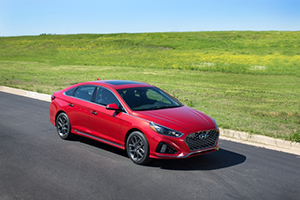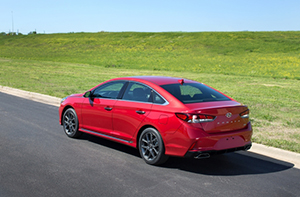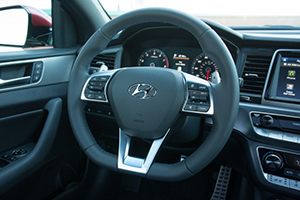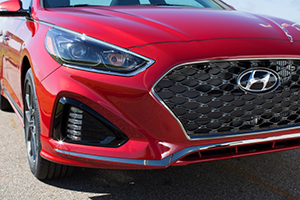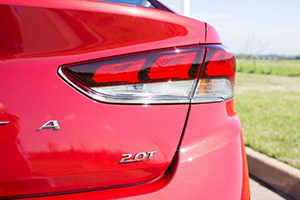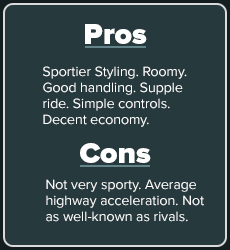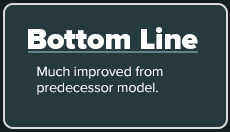2018 Hyundai Sonata Limited
The 2018 Hyundai Sonata Limited
is a mid-size sedan not to be overlooked.
Price: $27,600
The 2018 mid-size Hyundai Sonata sedan has a sportier look, key
mechanical changes and greater driving ease.
The front-drive Sonata Limited I tested was one of the top-line Sonata
sedans. There are more than half a dozen versions, including plug-in
and hybrid models. Sonatas range in price from $22,050 to $32,450. The
least costly has 178 turbocharged horsepower, while the top version has
a 245-horsepower turbo engine.
My test four-door Sonata was an approximately $27,600 non-turbo model
with a 2.4-liter 185-horsepower four-cylinder. It was quick in town and
provided decent 65-75 m.p.h. highway passing times. The tachometer only
showed a lazy 2,000 r.p.m. at 70 miles per hour.
Estimated fuel economy is 25 miles per gallon in the city and 35 on
highways. An 18.5-gallon tank swallows regular-grade fuel.
My test car had a responsive six-speed automatic transmission with a
good manual shift feature via a console transmission lever, although
the 245-horsepower Sonata has a new eight-speed automatic.
The 2018 Sonata has a new look from the front, side and rear. Its large
“cascading” grille, new hood, narrower headlights,
more assertive hatch-like profile and new rear with narrower taillights
and new trunk may give the impression that this is a sportier model
than it really is.
Still, the new Sonata has a refined chassis for surer handling and a
more supple ride. Hyundai increased the torsion bar stiffness with the
steering system to improve steering response and feel, although
steering is a little heavy. An updated suspension has trailing arms
that are thicker to better handle heavy suspension loads. New bushings
work with new suspension arms to allow more ride compliance and quicker
response time to better control wheel motions.
Handling is helped by a vehicle stability management system and
traction control. Handling is sure on winding roads, and the ride is
supple.
The recalibrated steering and suspension changes to improve handling
reportedly came from Albert Biermann, whom Hyundai stole from
illustrious BMW M several years ago.
Anti-lock brakes stop the car quickly and surely, assisted by
electronic brake force distribution and brake assist.
Still, this is no sports sedan—it isn’t supposed to
be. Rather, it’s a thoroughly pleasant mid-size car with lots
of room, especially in the rear-seat area, and a big trunk with a low,
wide opening. The split 60/40 rear seat backs fold forward without
groping for seat releases and sit flat for a larger cargo area.
The Limited is well-equipped, with such items as leather seating,
heated and ventilated front seats, power tilt-and-slide sunroof,
push-button start, automatic trunk opening, dual automatic temperature
control, manually adjustable steering wheel, AM/FM/CD radio and a
7-inch color touchscreen infotainment system with Apple CarPlay and
Android Auto compatibility, besides a 4.2-inch color LCD trip computer.
Visor vanity mirrors are lit.
A bunch of well-placed redundant dashboard switches came in handy.
My test car’s major safety options included automatic
emergency braking with pedestrian detection, lane-keep assist system,
smart cruise control with stop/start capability, rear parking sensors,
Infinity premium audio system and a heated steering wheel. That wheel
and the standard heated seats, made driving more comfortable in
zero-degree Chicago weather.
However, the options raised the Sonata Limited’s price,
including destination, to $31,310.
All doors, which have storage pockets, open wide to the quiet interior,
which has an upgraded appearance. The front seats offer adequate side
support. The analog gauges can be quickly read, and there’s
also a digital speedometer. Cupholders are conveniently situated on the
front console, while those in the rear are in the fold-down armrest.
The hood glides open on twin struts while the trunk has hinges.
The new Hyundai Sonata has a more solid feel than its predecessor,
which seems to be typical of Hyundai models as upgraded ones arrive
each new year.
